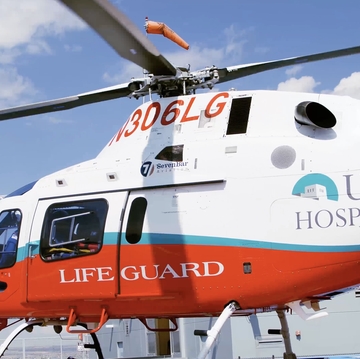New Mexico Approves Master of Science in Anesthesia Program at UNM

Mission of Mercy
Lifeguard Air Emergency Services Teams Brave Challenges to Transport Severely Ill COVID-19 Patients to UNM Hospital
The mission of transporting critically ill patients from rural areas in New Mexico to lifesaving medical care at the state's sole academic health center requires a dedicated team of professionals.
The pilots, medics and flight nurses in The University of New Mexico Hospital's Lifeguard Air Emergency Services program routinely bring in patients from around the state aboard fixed-wing and rotor aircraft.
During the COVID-19 pandemic Lifeguard's services are more in demand than ever - and the job has grown more challenging as a result.
"They pretty much have just changed their practice to treat every patient as COVID-positive, whether they are or not, just to be safe," says Jenn Vosburgh, RN, executive director for emergency services at UNMH, who oversee the Lifeguard program.
When a plane or helicopter is dispatched to pick up a patient, crews must don a full suite of personal protective equipment - masks, gowns, gloves and head coverings - before reaching the patient's bedside. The gear stays on for the duration of the trip back to Albuquerque, Vosburgh says.
"It has drastically changed their work flow," she says of the precautions. "It's hot and it's exhausting."
Lifeguard director Maggie O'Donnell says the overall patient volume has remained about the same over the past few months, but the pattern of transports has shifted, as the number of COVID-19 cases in San Juan and McKinley counties surged.
In March, 38 percent of transports came from the Four Corners region, including hospitals in Farmington and Gallup, as well as Indian Health Service facilities in Shiprock, Crownpoint, Ft. Defiance, Ariz., and Chinle, Ariz., O'Donnell says.
"In April , 45 percent of our volume was from that region," she says. "In the first half of May, it was 69 percent." Most of the patients were in respiratory distress and wound up in the UNMH intensive care unit, she adds.
The Lifeguard program is based in a hangar at the Albuquerque International Sunport. Helicopter pilot Randy Johnson joined the program four years ago after a long career flying for emergency medical transport services.
"It's rewarding," he says. "It's nice to be able to go out there and know that you're making a difference in somebody's life and provide a service that they need."
Compared to the medical crew and the meticulous infection prevention precautions they must take, "The pilot has the easy part of the job," Johnson says. Although the cockpit is isolated from the patients, pilots still wear an N95 respirator mask as a precaution, he says.
Flight nurse Megan Jarmosevich became interested in air medical transport while working as a paramedic in Rio Rancho.
"I remember the flight team swooping in when we had exhausted everything," she says. "They were always professional, they always worked fast and they knew what to do. You always looked up to them as like, 'That's the top, that's the most experienced, that's where you want to be.'"
Jarmosevich later spent six years as a pediatric ICU nurse before joining the Lifeguard team.
"The best part about our job is sometimes you can't believe you get paid to fly," she says. "The helicopter is so fun - the fact that you can immediately go leave, fly to the destination and pick up the patient, saving so much time. For a lot of our patients, time is life. Whether you're having a stroke or whether you're bleeding out, time matters."
The COVID-19 outbreak requires elaborate precautions to prevent viral spread, Jarmosevich says. Even after a patient is dropped off at UNMH, the aircraft is still considered contaminated until it returns to base, where it is aired out for an hour, then wiped down with disinfectants. The PPE stays on until they land.
"That's a big challenge," she says. "You're thirsty and hot. But we've all been very, very safe. No one has gotten sick, so I believe our PPE is working."
Jarmosevich remains undaunted by the difficulty of caring for patients who have tested positive for the novel coronavirus. "Even with this new world of transporting COVIDS and PPE, it still is the best job in the world, and I love every patient I take care of."